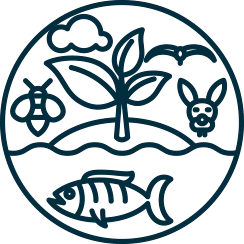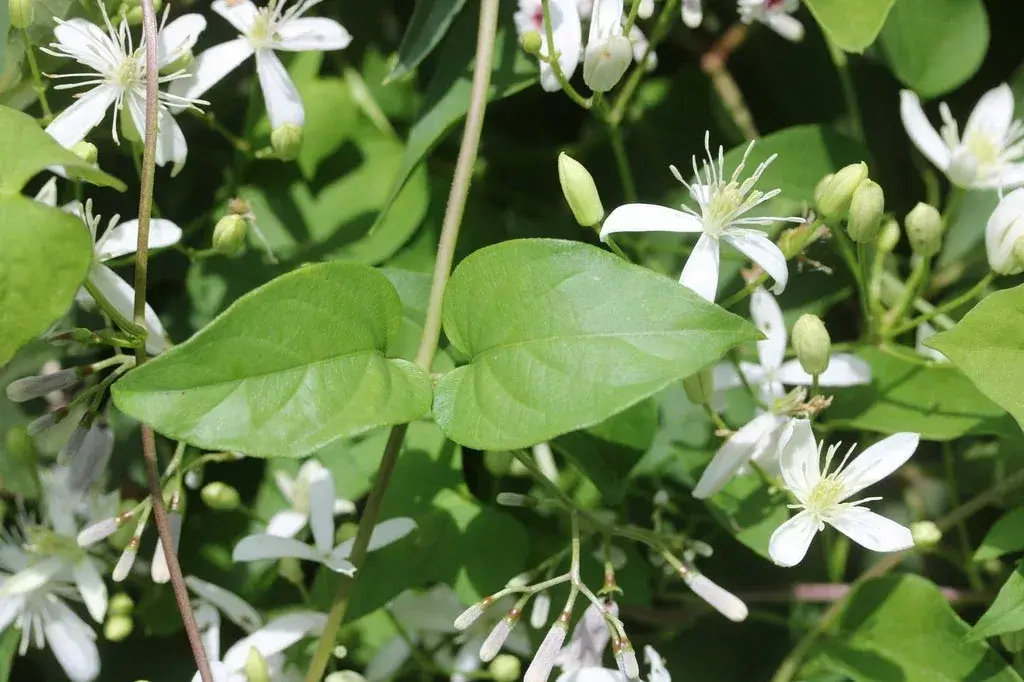
Japanese virgin’s bower (Clematis terniflora DC, also called sweet autumn clematis) is an invasive ornamental vine in the Clematis genus. It is widely planted in gardens for its profusion of small, showy white flowers in late summer and equally showy silvery, corkscrew, feathery seedheads. Given support it can reach 30’ in height. Its prolific nature and aggressive growth make it a problem in natural areas, where it can smother mature trees and displace native vegetation. Japanese virgin’s bower is on New York State’s regulated species list; it can be transported, purchased, sold and planted, but it can only be planted where it will not threaten natural areas, and must be displayed for sale with signs explaining that it is an invasive species.

Japanese virgin’s bower is native to Japan and China. It was brought to North America as an ornamental species. Leaves are opposite and compound, with three to five heart-shaped leaflets 2-3½” long; the surfaces are dark green and shiny, paler on the undersides. It climbs using tendril-like petioles to cling to support. Flowers are about 1” across, white, four-petaled, and held in clusters of 3-15; the plant blooms in late summer to fall. Seeds are small and brown, with showy, silvery-grey, feathery, curving seedheads.
Japanese virgin’s bower looks like many other Clematis genus species; the closest match is a native plant also commonly called virgin’s bower, Clematis virginiana. Flowers and seeds are similar between the two species, but leaves of C. virginiana are toothed and lobed as opposed to C. terniflora’s entire, ovate leaves. The other Clematis have larger flowers of various colors; these ornamental species and hybrids are not particularly aggressive.

Japanese virgin’s bower can survive a wide range of soil types and light availability, although it is most productive with shade on its roots and full sun on its foliage. It establishes in hedgerows, waste spaces, roadsides, stream banks and forest edges. It is a semi-woody perennial, producing foliage on new stems each year. In southern climates it is semi-evergreen. Japanese virgin’s bower produces shoots from last year’s woody stems in spring. It flowers in August and produces seeds by late September, which are dispersed by wind.

Cultural: The similar native virgin’s bower, Clematis virginiana, has many of the same ornamental characteristics as Japanese virgin’s bower and is less aggressive. They are so similar they are sometimes sold interchangeably at nurseries. Planting a native or noninvasive alternative will reduce the chances of this invasive damaging nearby natural areas.
Monitoring: Japanese virgin’s bower is most easily seen in the late summer, when it produces a froth of white flowers. Otherwise, look for a vine with small, oval- to heart-shaped, opposite leaves. There is currently no research on control of this species; all information is from gardening and extension sources.
Manual and Mechanical Control: Remove the plants and its roots. Some root fragments may resprout, so repeat visits may be necessary. Given the plant’s prolific nature, expect seeds still in the soil to continue to sprout new plants for some time. Research on the longevity of C. terniflora’s seeds in the soil is not available.
Biological Controls: Currently there are no biological controls for Japanese virgin’s bower.
Chemical Controls: Japanese virgin’s bower responds to control with glyphosate and triclopyr and other common broadleaf herbicides, with no known resistance issues. However, all will require repeat treatments (Langeland and Meisenburg, 2009). Before using chemical controls, always check with your state’s environmental regulatory agency to check on the legality of using any particular chemical.
This map shows confirmed observations (green points) submitted to the NYS Invasive Species Database. Absence of data does not necessarily mean absence of the species at that site, but that it has not been reported there. For more information, please visit iMapInvasives.
Invasive Plant Atlas of the United States: Sweet autumn virgin’s bower. Accessed 6/29/15 at http://www.invasiveplantatlas.org/subject.html?sub=5354.
Invasive Species Specialist Group (ISSG) of the IUCN Species Survival Commission. The Global Invasive Species Database: Clematis terniflora.
Langeland, Kenneth and Michael Meisenburg. 2009. Herbicide Evaluation to Control Clematis terniflora Invading Natural Areas in Gainesville, Florida. Plant Science and Management 2009 2:70–73.
Seiler, John; Edward Jensen, Alex Niemiera, and John Peterson. Virginia Tech VTree Profile: sweetautumn Clematis. Accessed at http://dendro.cnre.vt.edu/dendrology/syllabus/factsheet.cfm?ID=494 on 6/29/15.
Swearingen, J., B. Slattery, K. Reshetiloff, and S. Zwicker. 2010. Plant Invaders of Mid-Atlantic Natural Areas, 4th ed. National Park Service and U.S. Fish and Wildlife Service. Washington, DC. 168pp. Available online at https://www.invasive.org/alien/pubs/midatlantic/midatlantic.pdf
